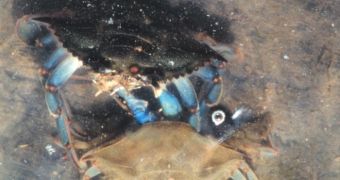These are the "Chip and Dales" of the crab world: the best performers of erotic dances in the world of the crustaceans. And their dances are extremely efficient, as they send pheromones to lure far-away females out of their dens, as found by a new research published in the "Journal of Experimental Biology." It appears that this is the best chance of the mates to find each other in the dense submarine copse of seagrass where blue crabs (Callinectes sapidus) live.
"Sending out a pheromone love letter helps the pair find one another," said co-author Charles Derby, a marine biologist at Georgia State University, in Atlanta.
The male blue crabs were known to dance in the wild, but in order to see the meaning of this dance, the research team examined crabs in a small aquarium. When a male and female were put together in the same tank, the male rushed upon the female.
Then, the researchers placed a divider separating the sexes. In this case, 10 out of 12 males executed a "stationary paddling": they leaned on their hind legs while fluttering their wide swimming arms. The team determined the speed of the formed currents using particle imaging velocimetry.
"The crustaceans managed to create a current that averaged 3 cm (1.2 in) per second and peaked at 17 cm (6.8 in) per second - enough to send pheromones a distance of up to 1 meter," said Derby, who pointed that the performances of the blue crabs in the wild are greater.
"These were not the most vigorous dancing crabs. I'm sure they can generate even faster currents. This behavior probably developed as an adaptation to the blue crab's habitat, full of sea grass and rocky hideaways, where males have a tough time seeing their mates," said Derby.
The team did not find the pheromone spread by the "dance", but previous researches had showed evidence for its existence and it could be released via their urine.
"Perhaps if she's able to detect this male odor, that would entice her to come out of hiding," said Rick Gleeson, a marine biologist at the Whitney Laboratory for Marine Science in St. Augustine, Florida, who points that males execute the paddling only when detecting the smell of a fertile female.

 14 DAY TRIAL //
14 DAY TRIAL //